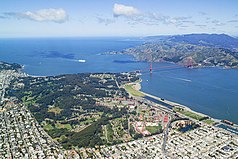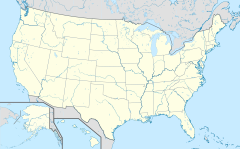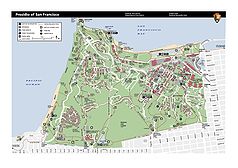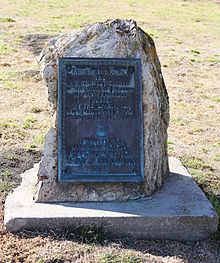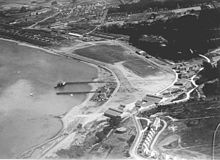Presidio (San Francisco)
| Presidio (San Francisco) | ||
|---|---|---|
| The six square kilometer former military base at the Golden Gate | ||
|
|
||
| Location: | California , United States | |
| Next city: | San Francisco | |
| Surface: | 6 km² | |
| Founding: | October 1, 1994 | |
| Map of the presidium | ||
The Presidio in San Francisco , California is a historic military base strategically located at the tip of the peninsula. Located right on the Golden Gate , the entrance to San Francisco Bay , it is the longest-used military base in the United States . The Presidio was used successively by the Spanish Armed Forces , the Mexican Military, and the United States Armed Forces from its inception by the Spanish in 1776 until 1994 .
In the two by three kilometer site there are 870 buildings, around 470 of which are historically significant. The Presidio was designated a National Historic Landmark District in 1962 and has been administered by the National Park Service since October 1, 1994 as part of the Golden Gate National Recreation Area . The Presidio Trust was founded in 1996 to use the area .
Its tasks include the commercial exploitation of the land for renting and leasing apartments and commercial space. The largest commercial tenants with around 61,000 m² are the former companies of George Lucas : LucasArts , Industrial Light and Magic and Lucasfilm have had offices for around 2,500 employees in the Presidio since 2005. The former quarters of the crews and officers are rented after renovations and conversions, which means that around 2500 people live on the site in a spectacular location.
history
The history of settlement on the peninsula of San Francisco goes back around 10,000 years, thus back to the Paleo-Indian period . An archaeological study of the presidium itself has only begun in recent years. The oldest, datable finds date from around 740. They show that the oldest detectable inhabitants of the region at the Golden Gate belonged to the Muwekma Ohlons , also known as Costanoan. This people, whose culture and language is assigned to the Penuti language family, lived as hunters and gatherers in families or in small villages and, depending on the season, moved from a permanent settlement down to the coast to fish or in the hills to hunt.
Spanish period (1776-1822)
In 1769, the visitador general of the Viceroyalty of New Spain , José de Gálvez y Gallardo , ordered that Spain's possessions on the Pacific coast should be expanded in order to reduce the influence of England and Russia in the Pacific Ocean. In the same year, Gaspar de Portolà sailed north on his behalf and founded San Diego, the first Spanish settlement in what is now the US state of California. Monterey , described by Sebastián Vizcaíno in 1602 , was planned as the second settlement . Because Vizcaíno's records about Monterey Bay differed significantly from reality, Portolà sailed beyond the goal. It is not entirely certain that he reached San Francisco Bay, but the men on his expedition are believed to be the first to see the Golden Gate . They reported one port of all ports that was explored more closely in the following year.
Pedro Fages , who was part of the Portolà expedition and who had been Portolà's successor as military governor of Nuevo California since the middle of the year , moved north from Monterey by land, reached the Santa Clara Valley and came across the east bank of the bay to the present day Alameda before. Since he could not cross the bay, he did not reach the Golden Gate but returned to Monterey. When he returned in March 1772, he was able to survey and map the entire bay for the first time. He also covered the Farallon Islands off the coast in the Pacific. His report aroused the interest of the head of all Spanish missions in California, the Franciscan Father Junípero Serra . This suggested the establishment of two new missions in the newly explored areas. When Fages did not support the project, he was replaced in 1774 and replaced by Fernando Rivera y Moncada . Rivera moved north from Monterey shortly thereafter and reached the tip of the headland at the Golden Gate on December 4, 1774, where he erected a wooden cross. At the beginning of the same year, Colonel Juan Bautista de Anza was the first Spaniard to explore the overland route from Sonora to the Pacific coast on behalf of the viceroy .
Because of his successful expedition, de Anza was commissioned to move to the Pacific again and create several new missions there. In addition, he was supposed to advance to the Golden Gate and erect a fortification there that would militarily secure the port for the Spanish crown. He recruited settlers to man the missions with and set out in the spring of 1775. In May he reached the Presidio San Ignacio de Tubac in what is now Tubac , Arizona. Juan Manuel de Ayala was sent out on the San Carlos sailboat to support him . He was supposed to enter the bay through the Golden Gate and explore it. On August 4, 1775, a pilot was the first European to enter the Bay of San Francisco in a rowboat, followed by Ayala on the San Carlos the next day . They stayed in the bay for 44 days and mapped the region. On their return to Monterey, they reported an excellent settlement area with good drinking water supply, a favorable climate and peaceful natives.
In response to this announcement, Juan Bautista de Anza set off from Tubac in October 1775, accompanied by 240 soldiers and settlers and 1,000 head of cattle. A Franciscan priest came with him . They reached Monterey in March 1775 and de Anza moved with a small advance division to the Golden Gate. From March 27 to April 5, they explored the range of hills on the peninsula and explored suitable locations for the Presidio and Mission Station. After their return to Monterey, de Anza was withdrawn to Mexico, the settlers undertake the last leg of their journey under the leadership of de Anza's deputy José Joaquín Moraga and the Franciscan Francisco Palóu . Only 193 settlers, some soldiers, some civilians, left Monterey and arrived on June 27th on the peninsula. After a period of exploration, on July 26th they began work on a small chapel that would be part of the presidium. In August, the San Carlos arrived under de Ayala and brought building materials, provisions and the experienced ship craftsmen with her. The construction plan was drawn by de Ayalas pilots and provided for a square of adobe buildings with an edge length of just over 80 m. The warehouse, the comandancia and the chapel were built by the sailors and ship craftsmen, the soldiers built their own accommodations. The chapel was consecrated on September 17th .
They built the first garrison on the present site and the Mission San Francisco de Asís mission station a little inland and the Pueblo de San José for civilians . The garrison in the Presidio was for a long time the northernmost institution of the viceroyalty and an outpost of colonization . It was connected to a chain of other Spanish missions , bases and settlements via El Camino Real (the Royal Way) , which stretched along the Pacific coast and along the few rivers in the interior of the continent.

The Presidio initially consisted of several elongated adobe adobe buildings around an almost square courtyard. In 1792 two small fortresses were built and cannons were installed. The Castillos had the task of guarding the entrance to the San Francisco Bay , which was the best natural harbor on the California coast. The later Fort Point emerged from the Castillo de San Joaquin . Between 200 and 300 settlers, mostly mestizos , lived around the military facility . Agriculture and especially the keeping of cattle and sheep changed the landscape and destroyed the livelihood of the indigenous people within a few decades.
At the beginning of the 19th century there were occasional economic disputes with Russian colonists who had built a settlement for the fur trade a little further north on Bodega Bay . As a result, hunters from this settlement were also held captive in the Presidio, as the Russian trade base was considered illegal by the Spanish. The conflicts intensified from 1812 onwards with the expansion of the Russian base at Fort Ross .
Mexican period (1822-1848)
The struggle for Mexican independence began in 1810 and lasted until formal recognition in 1822. After independence from Spain, the newly formed Mexican Army took over the Presidio. The outpost was in poor shape. Mexico did not take the affairs of the whole of Upper California (Alta California) very seriously , as there was no military threat either.
The neighboring city of San Francisco slowly grew into a center of the emerging fur trade. The population of the indigenous Ohlons had decreased in the last decades and the Mexicans were forcibly settled other peoples from the interior of the country on the coast to supply the food trade. Coast Miwok , Yokuts , Pomo , Sierra Miwok, and Salina have been relocated. The differences in their cultures were quickly lost.
In 1828, under the leadership of their alkali (village chief) Estanislao, a Yokut, the Indians of the region resisted exploitation and unfair trade. They moved from their settlement area near San José into the valley of the San Joaquim River and built a fortified village protected by palisades . They were able to withstand an initial attack by the presidio's few soldiers. In 1829 troops were drawn together from Monterey and the Presidio, and the villagers had nothing to counter their cannons. Estanislao himself escaped. He was pardoned a few years later. The small campaign was the only military action that the Mexican Garrison Presidios saw.
In 1835 the garrison moved from the Castellos to Sonoma . In the actual Presidio only a fuselage crew remained.
United States (1848–1994)
In the Mexican-American War , the troops of the United States occupied the now largely collapsed Presidio in 1846 without fighting. After the peace treaty and the cession of California to the USA in 1848, members of the US Army only sparingly repaired the buildings. Since the California gold rush had tripled the population within a few months in the same year , Washington upgraded the importance of California and San Francisco and made funds available for expanding the military. Meanwhile the commandant, Captain Keyes, had problems with deserters . Of his 57 men only 15 remained, all the others moved to the gold fields. Between 1853 and 1861 Fort Point , the fortification on Alcatraz Island, and Fort Mason were built to protect the San Francisco Bay. From 1862 onwards, construction work focused on the presidio itself.
During the Civil War , almost all Union troops were withdrawn from the west. Only in the Presidio and in Astoria at the mouth of the Columbia River in later Oregon were parts of the 9th US Infantry Regiment stationed. There was never any fighting on the Pacific coast. The experience in the east also showed that the previous fortifications no longer played a role in modern warfare. The Presidio was therefore completely redesigned. Before the plans could be implemented, the city of San Francisco began a campaign in 1870 for the transfer of most of the military site. The city grew rapidly and wanted the plots in prime locations. However, the military leadership declared the strategic position of the base to be indispensable and began the massive expansion.
The buildings in the various construction phases are considered to be outstanding examples of the architecture of their time: from the Victorian era to neoclassical brick buildings to a simplified form of Art Deco and, after the First World War, purely functional buildings that were seen as appropriate for government and military projects .
In the 1870s and 1880s, the Presidio became the most important location on the west coast. The troops stationed here were involved in all major Indian wars, including the most violent campaigns against the Apaches . The base was continuously expanded in order to fulfill the constantly increasing tasks. When the Yosemite , Sequoia and General Grant national parks were founded in California's Sierra Nevada in the 1890s, the US cavalry units stationed in the Presidio were responsible for controlling the new parks until the National Park Service was founded in 1916 .

In the Spanish-American War of 1898 and in the subsequent Philippine-American War until 1902, the Presidio was by far the most important base of the US armed forces. Thousands of soldiers were waiting to be embarked for the Philippines . The Presidio Army General Hospital (later renamed Letterman General Hospital ), the first permanent military hospital with comprehensive care, was built for the wounded in the wars . After the war in the Pacific, the 9th Cavalry Regiment, which was composed of black Americans and was referred to as Buffalo Soldiers , stayed in the Presidio and took over patrols in the national parks. During the great earthquake in San Francisco in 1906 , the US Army provided aid to thousands of injured and homeless people and set up camps on the site of the golf course, which was laid out in 1895 . In addition, she took over the functions of fire brigade and police and built communication lines until the civil services worked again.
In 1915, San Francisco was selected as the location for the Panama-Pacific International Exposition . The completion of the Panama Canal in 1914 was the occasion for a world exhibition of modern technology and culture. The city rebuilt after the earthquake was the perfect host for this show. Around two thirds of the exhibition space was in the Presidio. The “ Palace of Fine Arts ” and the semicircular exhibition hall have been preserved.
In 1916, troops of the Presidio on the Mexican Expedition under the command of General John Pershing moved south towards Pancho Villa . The First World War did not have much of an impact on the bases on the west coast. General Pershing, in command of the Presidio, was appointed Commander-in-Chief of the American Expeditionary Forces in Europe by US President Woodrow Wilson in 1917 .
In 1920, Crissy Field , the first US Army airfield on the west coast, was created to support the coastal fortification . Several pioneering achievements in aviation history began or ended here. The construction and opening of the Golden Gate Bridge (1934 to 1937), the southern end and access of which are on the premises of the Presidio, brought public transport to the previously largely closed peninsula. In 1937, the bridge allowed flight operations to be largely relocated to the new Hamilton Field airfield north of San Rafael on the other side of the bay.
During World War II , the Presidio again became the headquarters of the west coast and an important base of the Pacific War . The 4th US Army had its permanent headquarters here since 1936, and the first language school for the military intelligence service used the buildings on the old airfield. Between 1943 and 1945 1,750,000 men were embarked from San Francisco in the Pacific Fleet . The internment of Americans of Japanese descent was also organized from the Presidio . After the Second World War, the 6th US Army moved to its headquarters in the Presidio.
During the Cold War , the Presidio and Army on the west coast decreased in importance. A new function came with the erection of a screen of anti-aircraft missiles of the " Nike " type around the Bay of San Francisco. During the Vietnam War , the strong anti-war movement in the city of San Francisco influenced the soldiers in the Presidio. In October 1968, the protest of conscripts about an unexplained death while under military arrest sparked the so-called “Presidio Mutiny”, which is considered one of the most influential protests within the army.
In 1962, the entire site was placed under ensemble protection as a National Historic Landmark District . Today, more than 450 buildings are considered valuable architectural monuments. In 1989 the US Congress decided to give up the base. After the army withdrew in 1994, the Presidio was placed under the administration of the National Park Service , which maintains the grounds as part of the Golden Gate National Recreation Area .
Buildings and current use
The Presidio is the only National Park Service facility that is entirely self-financing. The Presidio Trust , a foundation under US federal law, was established in 1996 to utilize the site . Originally, costs were to be covered by 2013, but the trust was able to present a balanced budget as early as 2005 . A total of around 150 commercial and non-profit companies and 2500 residents use the area.
The residential areas of crews and officers as well as commercial buildings on the edge of the site are almost completely let. Some of the officers' buildings with spectacular views of the Golden Gate Bridge and San Francisco Bay are among the most valuable residential areas in the world and achieve corresponding rental prices. The trust is mainly financed from the income from the rented apartments.
The Presidio Trust plans to use the proceeds to upgrade the site in the medium term according to nature conservation aspects. Native plants should be given preference in the forests on the edge of the presidio and on recreational areas. The biggest plan is to restore the Tennessee Valley Hollow Watershed , a cased spring with natural watercourses in the hills on the west side since the early 20th century. Since 2008, the watercourse has been renatured in several sections.
Conflicts

Conflicts arise because both the National Park Service and the Presidio Trust operate solely under US federal law. The City of San Francisco and the State of California have no say in the use of the property and do not generate any tax revenue from the rental. Therefore, the city has little interest in cooperation. Even after more than ten years, there is no integrated concept for connecting residential areas and commercial complexes to the public transport system in San Francisco, which is exceptionally well developed by US standards. Instead, the Presidio Trust operates its own system of shuttle buses that connect the site to local public transport.
Important building complexes and facilities
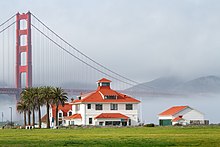
- Main Post: In the old core of the presidio, parts of the first adobe buildings from 1793, which were integrated into the former officers' club, have been preserved. The building has been renovated and is used as an exhibition hall. The former barracks of the men and the officers' quarters from the 1890s around Paradeplatz have been almost completely restored and rented out. In addition to companies in the real estate and financial sector as well as several educational institutions, cheaper spaces have been reserved for non-profit organizations.
- Fort Point : The fort under the Golden Gate Bridge from 1861 is designated as a National Historic Site and can be visited by the public.
- San Francisco National Cemetery: About 15,000 soldiers from various wars since the 1880s are buried at the national war cemetery, including a little over 500 "unknown soldiers".
- Presidio Golf Course: The golf course was laid out in 1895 and expanded to 18 holes after the earthquake in 1910. It was reserved for military personnel until 1994 and is now open to the public. It contributes significantly to the green impression of the entire site.
- Letterman General Hospital: The former military hospital from 1899 was demolished and the Letterman Digital Arts Center, built on the same site, was leased to LucasArts , Lucasfilm and Industrial Light and Magic for 50 years in 2005 . The companies founded by George Lucas have been subsidiaries of the Walt Disney Company since 2012 and have bundled their management as well as the online , legal and marketing departments in the Presidio .
- Battery Chamberlin: Several gun emplacements were built on the Pacific side at the beginning of the 20th century . The Battery Chamberlin in the north-west, near the Golden Gate Bridge, is the only surviving disappearance on the west coast and can be visited.
- Public Health Service Hospital: The former hospital is the largest single building in the presidio. The side wings of the 1932 building added in the 1950s were demolished. The main building on the southern edge of the site was converted into upscale apartments by 2010 and awarded for the renovation according to modern environmental standards. The associated residential buildings for hospital employees are also rented.
- Fort Winfield Scott: The largest complex of buildings on the site (from 1910 named after Army General Winfield Scott ) has been partially renovated. In 2014 the Presidio Trust opened the Presidio Institute , a research and educational institution.
- Crissy Field , a former military airport on the edge of San Francisco Bay , now used as a recreational area.
- The Presidio Theater was renovated until 2019 and reopened in September of that year.
Significant users
- Disney's Lucasfilm and ILM companies are the largest tenants
- Alexa Internet
- San Francisco Film Center
- More than thirty non-profit organizations in the arts, education and environmental protection, including the Wiki Education Foundation since 2014 .
- The Walt Disney Family Museum about the life of Walt Disney opened in the fall of 2009 in one of the brick buildings on Paradeplatz and two associated outbuildings.
- The Contemporary Art Museum at the Presidio was to be built by 2011 on the premises and the collection of contemporary art by Donald and Doris Fischer exhibit. The location of the project, which is to include a hotel and a cinema in addition to the exhibition rooms, is controversial; the proposal to build it on Paradeplatz in the core of the presidio was rejected in August 2008 at a hearing by the monument protection office.
landscape
In addition to the built-up area, the Presidio also includes large areas in a natural state. The rocky coast on the western flank of the peninsula is rugged at the top and drops steeply to the Pacific. There are beaches to the south. Sitka spruces and various buckthorns grow on the rocks . Sand verbenias and sea mustard bloom on the slopes of the beach . Several pairs of the endangered Kentish plover also breed here .
On the inside of the bay, below the old military airfield, there is a small swamp area. It is valuable as a habitat for flowering plants, amphibians and water birds.
Presidio and Media
Alfred Hitchcock discovered the Presidio in 1958 as the setting and location for his film Vertigo - From the Realm of the Dead , with James Stewart and Kim Novak .
Later films shot at the Presidio include:
- Presidio , 1988, with Sean Connery , Mark Harmon and Meg Ryan in the lead roles, directed and directed by Peter Hyams .
- The Death Game , 1988, with Clint Eastwood
- The Game , 1997, with Michael Douglas and Sean Penn
- Dr. Dolittle 2 , 2001 with Eddie Murphy
In the fictional universe of Star Trek , the headquarters of Starfleet is in the Presidio of San Francisco.
Since the withdrawal of the army, the abandoned facilities have often served as a backdrop for shooting music videos.
literature
- Erwin N. Thompson, Defender of the Gate - A History from 1846 to 1995 , National Park Service, 1997 - also available for download from the National Park Service website (PDF, 1.9 MB)
Web links
- Literature by and about Presidio (San Francisco) in the WorldCat bibliographic database
- National Park Service: Presidio of San Francisco (official site; English)
- Official site of the Presidio Trust (English)
- Randy Rowland: The Presidio Mutiny ( Memento from June 22, 2006 in the Internet Archive ) - Report by one of the participants on the Presidio mutiny of 1968 (English)
Individual evidence
- ↑ Unless otherwise stated, the prehistory is based on: National Park Service: Presidio of San Francisco - Indigenous Period
- ^ John Phillip Langelier, Daniel Bernard Rosen: El Presidio de San Francisco: A History under Spain and Mexico 1776-1846 . National Park Service, 1992. Prologue, pp. 5-7
- ↑ Unless otherwise stated, the presentation of the history of the Presidio under Spanish administration is based on: John Phillip Langelier, Daniel Bernard Rosen: El Presidio de San Francisco: A History under Spain and Mexico 1776-1846 . National Park Service, 1992.
- ↑ Listing of National Historic Landmarks by State: California. National Park Service , accessed August 3, 2019.
- ↑ Presidio Trust: Revitalizing Tennessee Hollow ( Memento of the original from October 7, 2012 in the Internet Archive ) Info: The archive link was inserted automatically and has not yet been checked. Please check the original and archive link according to the instructions and then remove this notice.
- ↑ Presidio Trust: A "Green" Revitalization ( Memento of the original from September 16, 2012 in the Internet Archive ) Info: The archive link was inserted automatically and has not yet been checked. Please check the original and archive link according to the instructions and then remove this notice. , accessed July 11, 2012
- ↑ Presidio Institute: About ( Memento of the original from October 27, 2014 in the Internet Archive ) Info: The archive link was inserted automatically and has not yet been checked. Please check the original and archive link according to the instructions and then remove this notice.
